Distribution Characteristics and Ecological Risk Assessment of Organophosphate Esters in Surface Soils of China
Abstract
:1. Introduction
2. Materials and Methods
2.1. Data Sourcing and Screening
2.2. Ecological Risk Assessment
3. Results and Discussion
3.1. Source of OPEs in Soil
3.2. Exposure of Soil to OPEs
3.2.1. OPE Exposure Levels in Soils from Different Regions
3.2.2. OPE Exposure Levels in Soils of Different Functional Zones
3.2.3. OPE Exposure Levels in Soil at Different Times
3.3. Ecological Risks of OPEs
4. Conclusions
Supplementary Materials
Author Contributions
Funding
Institutional Review Board Statement
Informed Consent Statement
Data Availability Statement
Conflicts of Interest
References
- Lugo-Bueno, S.F.; García-Morales, R.; Coronel, R.; Aguilar-Hernandez, I.; Becerril-Bravo, J.E.; Barrios-Perez, J.A.; Mahlknecht, J.; Cano-Quiroz, A.; Ornelas-Soto, N. Biocatalysis assisted by electrochemical processes for the removal of bisphenol A and triclosan in wastewater. Environ. Technol. Innov. 2022, 28, 102921. [Google Scholar] [CrossRef]
- Tran-Lam, T.T.; Pham, P.T.; Bui, M.Q.; Dao, Y.H.; Le, G.T. Organophosphate esters and their metabolites in marine fish from Vietnam: Analytical method development and validation. J. Food Compos. Anal. 2024, 131, 106266. [Google Scholar] [CrossRef]
- Bacaloni, A.; Cucci, F.; Guarino, C.; Nazzari, M.; Samperi, R.; Lagana, A. Occurrence of organophosphorus flame retardant and plasticizers in three volcanic lakes of Central Italy. Environ. Sci. Technol. 2008, 42, 1898–1903. [Google Scholar] [CrossRef] [PubMed]
- Tian, Y.X.; Chen, H.Y.; Ma, J.; Liu, Q.Y.; Qu, Y.J.; Zhao, W.H. A critical review on sources and environmental behavior of organophosphorus flame retardants in the soil: Current knowledge and future perspectives. J. Hazard. Mater. 2023, 452, 131161. [Google Scholar] [CrossRef]
- Marklund, A.; Andersson, B.; Haglund, P. Screening of organophosphorus compounds and their distribution in various indoor environments. Chemosphere 2003, 53, 1137–1146. [Google Scholar] [CrossRef]
- Wei, G.L.; Li, D.Q.; Zhuo, M.N.; Liao, Y.S.; Xie, Z.Y.; Guo, T.L.; Li, J.J.; Zhang, S.Y.; Liang, Z.Q. Organophosphorus flame retardants and plasticizers: Sources, occurrence, toxicity and human exposure. Environ. Pollut. 2015, 196, 29–46. [Google Scholar] [CrossRef]
- Yan, Z.F.; Feng, C.L.; Jin, X.W.; Liu, D.Q.; Hong, Y.J.; Qiao, Y.; Bai, Y.C.; Moon, H.B.; Qadeer, A.; Wu, F.C. In vitro metabolic kinetics of cresyl diphenyl phosphate (CDP) in liver microsomes of crucian carp (Carassius carassius). Environ. Pollut. 2021, 274, 116586. [Google Scholar] [CrossRef]
- Yang, J.W.; Zhao, Y.Y.; Li, M.H.; Du, M.J.; Li, X.X.; Li, Y. A Review of a Class of Emerging Contaminants: The Classification, Distribution, Intensity of Consumption, Synthesis Routes, Environmental Effects and Expectation of Pollution Abatement to Organophosphate Flame Retardants (OPFRs). Int. J. Mol. Sci. 2019, 20, 2874. [Google Scholar] [CrossRef] [PubMed]
- Zheng, C.L.; Feng, S.S.; Liu, P.P.; Fries, E.; Wang, Q.R.; Shen, Z.X.; Liu, H.X.; Zhang, T.C. Sorption of Organophosphate Flame Retardants on Pahokee Peat Soil. Clean-Soil Air Water 2016, 44, 1163–1173. [Google Scholar] [CrossRef]
- Ou, Y.X. Developments of organic phosphorus flame retardant industry in China. Chem. Ind. Eng. Prog. 2011, 30, 210–215. (In Chinese) [Google Scholar] [CrossRef]
- Chen, Y.Q.; Zhang, Q.; Luo, T.W.; Xing, L.Q.; Xu, H.Z. Occurrence, distribution and health risk assessment of organophosphate esters in outdoor dust in Nanjing, China: Urban vs. rural areas. Chemosphere 2019, 231, 41–50. [Google Scholar] [CrossRef] [PubMed]
- Du, B.B.; Shen, M.J.; Chen, H.; Zhang, Y.; Deng, M.; Li, J.; Zeng, L.X. Beyond Traditional Organophosphate Triesters: Prevalence of Emerging Organophosphate Triesters and Organophosphate Diesters in Indoor Dust from a Mega E-waste Recycling Industrial Park in South China. Environ. Sci. Technol. 2020, 54, 12001–12012. [Google Scholar] [CrossRef] [PubMed]
- Wang, Y.; Li, Z.Y.; Tan, F.; Xu, Y.; Zhao, H.X.; Chen, J.W. Occurrence and air-soil exchange of organophosphate flame retardants in the air and soil of Dalian, China. Environ. Pollut. 2020, 265, 114850. [Google Scholar] [CrossRef] [PubMed]
- Kim, U.J.; Kannan, K. Occurrence and Distribution of Organophosphate Flame Retardants/Plasticizers in Surface Waters, Tap Water, and Rainwater: Implications for Human Exposure. Environ. Sci. Technol. 2018, 52, 5625–5633. [Google Scholar] [CrossRef]
- Xing, L.Q.; Tao, M.; Zhang, Q.; Kong, M.; Sun, J.; Jia, S.Y.; Liu, C.H. Occurrence, spatial distribution and risk assessment of organophosphate esters in surface water from the lower Yangtze River Basin. Sci. Total Environ. 2020, 734, 139380. [Google Scholar] [CrossRef]
- Tan, X.X.; Luo, X.J.; Zheng, X.B.; Li, Z.R.; Sun, R.X.; Mai, B.X. Distribution of organophosphorus flame retardants in sediments from the Pearl River Delta in South China. Sci. Total Environ. 2016, 544, 77–84. [Google Scholar] [CrossRef]
- Ding, J.; Xu, Z.; Huang, W.; Feng, L.; Yang, F. Organophosphate ester flame retardants and plasticizers in human placenta in Eastern China. Sci. Total Environ. 2016, 554, 211–217. [Google Scholar] [CrossRef]
- Wang, Y.X.; Duan, Y.S.; Geng, C.Z. Occurrence of organophosphate ester in aquatic environment and ecological risk assessment. J. Environ. Health 2015, 32, 935–939. (In Chinese) [Google Scholar] [CrossRef]
- Fries, E.; Mihajlovic, I. Pollution of soils with organophosphorus flame retardants and plasticizers. J. Environ. Monit. 2011, 13, 2692–2694. [Google Scholar] [CrossRef]
- Matsukami, H.; Tue, N.M.; Suzuki, G.; Someya, M.; Tuyen, L.H.; Viet, P.H.; Takahashi, S.; Tanabe, S.; Takigami, H. Flame retardant emission from e-waste recycling operation in northern Vietnam: Environmental occurrence of emerging organophosphorus esters used as alternatives for PBDEs. Sci. Total Environ. 2015, 514, 492–499. [Google Scholar] [CrossRef]
- Han, B.; Chen, L.; Li, Y.; Yu, L.; Zhang, J.; Tao, S.; Liu, W. Spatial distribution and risk assessment of 11 organophosphate flame retardants in soils from different regions of agricultural farmlands in mainland China. Sci. Total Environ. 2022, 842, 156806. [Google Scholar] [CrossRef] [PubMed]
- Ji, Y.; Wang, Y.; Yao, Y.M.; Ren, C.; Lan, Z.H.; Fang, X.G.; Zhang, K.; Sun, W.J.; Alder, A.C.; Sun, H.W. Occurrence of organophosphate flame retardants in farmland soils from Northern China: Primary source analysis and risk assessment. Environ. Pollut. 2019, 247, 832–838. [Google Scholar] [CrossRef] [PubMed]
- Ren, G.F.; Chu, X.D.; Zhang, J.; Zheng, K.W.; Zhou, X.Y.; Zeng, X.Y.; Yu, Z.Q. Organophosphate esters in the water, sediments, surface soils, and tree bark surrounding a manufacturing plant in north China. Environ. Pollut. 2019, 246, 374–380. [Google Scholar] [CrossRef] [PubMed]
- Wang, Y.; Sun, H.; Zhu, H.; Yao, Y.; Chen, H.; Ren, C.; Wu, F.; Kannan, K. Occurrence and distribution of organophosphate flame retardants (OPFRs) in soil and outdoor settled dust from a multi-waste recycling area in China. Sci. Total Environ. 2018, 625, 1056–1064. [Google Scholar] [CrossRef] [PubMed]
- Sun, Y.L.; Zhu, H.K. A pilot study of organophosphate esters in surface soils collected from Jinan City, China: Implications for risk assessments. Environ. Sci. Pollut. Res. 2021, 28, 3344–3353. [Google Scholar] [CrossRef]
- van der Veen, I.; de Boer, J. Phosphorus flame retardants: Properties, production, environmental occurrence, toxicity and analysis. Chemosphere 2012, 88, 1119–1153. [Google Scholar] [CrossRef]
- Araki, A.; Saito, I.; Kanazawa, A.; Morimoto, K.; Nakayama, K.; Shibata, E.; Tanaka, M.; Takigawa, T.; Yoshimura, T.; Chikara, H.; et al. Phosphorus flame retardants in indoor dust and their relation to asthma and allergies of. Indoor Air 2014, 24, 3–15. [Google Scholar] [CrossRef]
- Carignan, C.C.; Minguez-Alarcon, L.; Butt, C.M.; Williams, P.L.; Meeker, J.D.; Stapleton, H.M.; Toth, T.L.; Ford, J.B.; Hauser, R.; Team, E.S. Urinary Concentrations of Organophosphate Flame Retardant Metabolites and Pregnancy Outcomes among Women Undergoing in Vitro Fertilization. Environ. Health Perspect. 2017, 125, 087018. [Google Scholar] [CrossRef]
- Yao, M.Y. The Effects of Tris (2-Chloroethyl) Phosphate (TCEP) Stress on Wheat Seeds Germination and Physiological Characteristics. Master’s Thesis, Zhengzhou University, Zhengzhou, China, 2021. [Google Scholar]
- Yang, Y. Ecotoxicity effect and mechanism of organophosphorus esters (OPEs) on earthworm Eisenia fetida. Ph.D. Thesis, Nanjing University, Nanjing, China, 2018. [Google Scholar]
- The General Office of the State Council. Notice of the General Office of the State Council on Issuing Action Plans for the Treatment of New Pollutants. Available online: http://www.gov.cn/zhengce/content/2022-05/24/content_5692059.htm (accessed on 10 June 2024).
- Tian, Y.X.; Wang, Y.; Chen, H.Y.; Ma, J.; Liu, Q.Y.; Qu, Y.J.; Sun, H.W.; Wu, L.N.; Li, X.L. Organophosphate esters in soils of Beijing urban parks: Occurrence, potential sources, and probabilistic health risks. Sci. Total Environ. 2023, 879, 162855. [Google Scholar] [CrossRef]
- Lei, Q.T.; Shi, Y.L.; Tang, Z.; Niu, L.; Zhao, X.L. Pollution Characteristics and Ecological Risk Assessment of Organophosphate Esters in Qinghe River, Beijing. Res. Environ. Sci. 2023, 36, 836–847. (In Chinese) [Google Scholar] [CrossRef]
- Cao, M. Comprehensive investigation and risk assessment of contaminants of emerging concerns in Yellow River Estuary. Master’s Thesis, Lanzhou Jiaotong University, Lanzhou, China, 2023. [Google Scholar]
- European Commission. Identification and Evaluation of Data on Flame Retardants in Consumer Products; European Commission Health & Consumers DG: Brussels, Belgium, 2011. [Google Scholar]
- Fu, L.; Du, B.; Wang, F.; Lam, J.C.W.; Zeng, L.; Zeng, E.Y. Organophosphate Triesters and Diester Degradation Products in Municipal Sludge from Wastewater Treatment Plants in China: Spatial Patterns and Ecological Implications. Environ. Sci. Technol. 2017, 51, 13614–13623. [Google Scholar] [CrossRef] [PubMed]
- Stapleton, H.M.; Klosterhaus, S.; Eagle, S.; Fuh, J.; Meeker, J.D.; Blum, A.; Webster, T.F. Detection of Organophosphate Flame Retardants in Furniture Foam and US House Dust. Environ. Sci. Technol. 2009, 43, 7490–7495. [Google Scholar] [CrossRef] [PubMed]
- Yin, H.L.; Luo, Y.; Song, J.J.; Li, S.P.; Lin, S.Y.; Xiong, Y.M.; Fang, S.H.; Tang, J. Pollution characteristics and emissions of typical organophosphate esters of a wastewater treatment plant. Environ. Sci. Pollut. Res. 2022, 29, 25892–25901. [Google Scholar] [CrossRef]
- Xiong, J.J.; Li, H.Z.; Ma, X.; Tan, B.X.; You, J. A new configuration of polar organic chemical integrative sampler with nylon membranes to monitor emerging organophosphate ester contaminants in urban surface water. Ecotoxicol. Environ. Saf. 2020, 202, 110891. [Google Scholar] [CrossRef] [PubMed]
- Salamova, A.; Peverly, A.A.; Venier, M.; Hites, R.A. Spatial and Temporal Trends of Particle Phase Organophosphate Ester Concentrations in the Atmosphere of the Great Lakes. Environ. Sci. Technol. 2016, 50, 13249–13255. [Google Scholar] [CrossRef]
- Takimoto, K.; Hirakawa, T.; Ito, K.; Mukai, T.; Okada, M. Source and transport of tricresyl phosphate (TCP) isomers in Kurose river basin. Atmos. Environ. 1999, 33, 3191–3200. [Google Scholar] [CrossRef]
- Tian, Y.X. Study on the Occurrence Status and Environmental Risk of Organophosphate Esters in Soils of Beijing Urban Parks. Master’s Thesis, Chinese Research Academy of Environmental Sciences, Beijing, China, 2023. [Google Scholar]
- Cui, K.Y.; Wen, J.X.; Zeng, F.; Li, S.C.; Zhou, X.; Zeng, Z.X. Occurrence and distribution of organophosphate esters in urban soils of the subtropical city, Guangzhou, China. Chemosphere 2017, 175, 514–520. [Google Scholar] [CrossRef]
- Zhang, Q.; Wang, Y.X.; Jiang, X.X.; Xu, H.Z.; Luo, Y.Q.; Long, T.T.; Li, J.; Xing, L.Q. Spatial occurrence and composition profile of organophosphate esters (OPEs) in farmland soils from different regions of China: Implications for human exposure. Environ. Pollut. 2021, 276, 116729. [Google Scholar] [CrossRef]
- Wang, Y.; Zhang, Z.H.; Bao, M.J.; Xu, Y.; Zhang, L.J.; Tan, F.; Zhao, H.X. Characteristics and risk assessment of organophosphate esters and phthalates in soils and vegetation from Dalian, northeast China. Environ. Pollut. 2021, 284, 117532. [Google Scholar] [CrossRef]
- He, M.J.; Yang, T.; Yang, Z.H.; Zhou, H.; Wei, S.Q. Current State, Distribution, and Sources of Phthalate Esters and Organophosphate Esters in Soils of the Three Gorges Reservoir Region, China. Arch. Environ. Contam. Toxicol. 2018, 74, 502–513. [Google Scholar] [CrossRef]
- Luo, Q.; Gu, L.Y.; Shan, Y.; Wang, H.; Sun, L. Human Health Risk Assessment of Organophosphate Esters in Urban Topsoils of Shenyang, China. Pol. J. Environ. Stud. 2020, 29, 2731–2742. [Google Scholar] [CrossRef]
- Tang, J.; Sun, J.; Ke, Z.; Yin, H.; Yang, L.; Yen, H.; Li, X.; Xu, Y. Organophosphate esters in surface soils from a heavily urbanized region of Eastern China: Occurrence, distribution, and ecological risk assessment. Environ. Pollut. 2021, 291, 118200. [Google Scholar] [CrossRef] [PubMed]
- Liu, L.Y.; Yin, H.L.; Jian, L.J.; Xu, Z.W.; Xiong, M.Y.; Luo, Y.; Liu, X.W.; Xu, W.X. Pollution Characteristics of Organophosphate Esters in Frozen Soil on the Eastern Edge of Qinghai-Tibet Plateau. Environ. Sci. 2021, 42, 3549–3554. (In Chinese) [Google Scholar] [CrossRef]
- Zhu, T. Occurrence, Source and Ecological Risks of Organophosphate esters in the Water and Soil Environment of Villages in Typical Regions of China. Master’s Thesis, Chongqing University, Chongqing, China, 2022. [Google Scholar]
- He, M.J.; Yang, T.; Yang, Z.H.; Li, Q.; Wei, S.Q. Occurrence and Distribution of Organophosphate Esters in Surface Soil and Street Dust from Chongqing, China: Implications for Human Exposure. Arch. Environ. Contam. Toxicol. 2017, 73, 349–361. [Google Scholar] [CrossRef] [PubMed]
- Wang, C.; Yuan, R.Y.; Wei, S.Q.; He, M.J. Occurrence, correlation, and partitioning of organophosphate esters in soil and tree bark from a megacity, Western China. Environ. Sci. Pollut. Res. 2023, 30, 4359–4371. [Google Scholar] [CrossRef]
- Yang, Z.H.; He, M.J.; Yang, T.; Lu, J.F.; Wei, S.Q. Occurrence and Distribution of the Organophosphate Esters in Soils of Mixed land Use Area in Chongqing City. Environ. Sci. 2018, 39, 5135–5141. (In Chinese) [Google Scholar]
- Chen, Z.M. Distribution, Source and Ecological Risk Assessment of Organophosphate in the Water and Soil at Village Scale in Cold Region. Chongqing University, Chongqing, China, 2021.
- Wang, Y.; Yao, Y.; Li, W.; Zhu, H.; Wang, L.; Sun, H.; Kannan, K. A nationwide survey of 19 organophosphate esters in soils from China: Spatial distribution and hazard assessment. Sci. Total Environ. 2019, 671, 528–535. [Google Scholar] [CrossRef]
- La Guardia, M.J.; Hale, R.C. Halogenated flame-retardant concentrations in settled dust, respirable and inhalable particulates and polyurethane foam at gymnastic training facilities and residences. Environ. Int. 2015, 79, 106–114. [Google Scholar] [CrossRef]
- Andresen, J.A.; Grundmann, A.; Bester, K. Organophosphorus flame retardants and plasticisers in surface waters. Sci. Total Environ. 2004, 332, 155–166. [Google Scholar] [CrossRef]
- He, C.; Wang, X.Y.; Thai, P.; Mueller, J.F.; Gallen, C.; Li, Y.; Baduel, C. Development and validation of a multi-residue method for the analysis of brominated and organophosphate flame retardants in indoor dust. Talanta 2017, 164, 503–510. [Google Scholar] [CrossRef]
- Xu, F.C.; Giovanoulis, G.; van Waes, S.; Padilla-Sanchez, J.A.; Papadopoulou, E.; Magnér, J.; Haug, L.S.; Neels, H.; Covaci, A. Comprehensive Study of Human External Exposure to Organophosphate Flame Retardants via Air, Dust, and Hand Wipes: The Importance of Sampling and Assessment Strategy. Environ. Sci. Technol. 2016, 50, 7752–7760. [Google Scholar] [CrossRef] [PubMed]
- Ali, N.; Eqani, S.; Ismail, I.M.I.; Malarvannan, G.; Kadi, M.W.; Albar, H.M.S.; Rehan, M.; Covaci, A. Brominated and organophosphate flame retardants in indoor dust of Jeddah, Kingdom of Saudi Arabia: Implications for human exposure. Sci. Total Environ. 2016, 569, 269–277. [Google Scholar] [CrossRef]
- Cristale, J.; Hurtado, A.; Gomez-Canela, C.; Lacorte, S. Occurrence and sources of brominated and organophosphorus flame retardants in dust from different indoor environments in Barcelona, Spain. Environ. Res. 2016, 149, 66–76. [Google Scholar] [CrossRef] [PubMed]
- Wu, M.; Yu, G.; Cao, Z.; Wu, D.; Liu, K.; Deng, S.; Huang, J.; Wang, B.; Wang, Y. Characterization and human exposure assessment of organophosphate flame retardants in indoor dust from several microenvironments of Beijing, China. Chemosphere 2016, 150, 465–471. [Google Scholar] [CrossRef]
- Abdallah, M.A.-E.; Covaci, A. Organophosphate Flame Retardants in Indoor Dust from Egypt: Implications for Human Exposure. Environ. Sci. Technol. 2014, 48, 4782–4789. [Google Scholar] [CrossRef] [PubMed]
- Ingerowski, G.; Friedle, A.; Thumulla, J. Chlorinated ethyl and isopropyl phosphoric acid triesters in the indoor environment—An inter-laboratory exposure study. Indoor Air-Int. J. Indoor Air Qual. Clim. 2001, 11, 145–149. [Google Scholar] [CrossRef]
- Wan, W.N.; Zhang, S.Z.; Huang, H.L.; Wu, T. Occurrence and distribution of organophosphorus esters in soils and wheat plants in a plastic waste treatment area in China. Environ. Pollut. 2016, 214, 349–353. [Google Scholar] [CrossRef]
- Zhou, Y.C.; Li, X.; Tao, K.; Li, H.R.; Hua, P.; Dai, Y.N.; Fu, Z.; Zhang, J.; Gui, D.W. Distribution characteristics, health risks, and source apportionment of organophosphate esters in road dust and soil. Acta Sci. Circumstantiae 2024, 44, 352–365. (In Chinese) [Google Scholar]
- Langer, S.; Fredricsson, M.; Weschler, C.J.; Bekö, G.; Strandberg, B.; Remberger, M.; Toftum, J.; Clausen, G. Organophosphate esters in dust samples collected from Danish homes and daycare centers. Chemosphere 2016, 154, 559–566. [Google Scholar] [CrossRef]
- Kurt-Karakus, P.; Alegria, H.; Birgul, A.; Gungormus, E.; Jantunen, L. Organophosphate ester (OPEs) flame retardants and plasticizers in air and soil from a highly industrialized city in Turkey. Sci. Total Environ. 2018, 625, 555–565. [Google Scholar] [CrossRef]
- Blum, A.; Behl, M.; Birnbaum, L.S.; Diamond, M.L.; Phillips, A.; Singla, V.; Sipes, N.S.; Stapleton, H.M.; Venier, M. Organophosphate Ester Flame Retardants: Are They a Regrettable Substitution for Polybrominated Diphenyl Ethers? Environ. Sci. Technol. Lett. 2019, 6, 638–649. [Google Scholar] [CrossRef] [PubMed]
- Li, H.; La Guardia, M.J.; Liu, H.; Hale, R.C.; Mainor, T.M.; Harvey, E.; Sheng, G.; Fu, J.; Peng, P. Brominated and organophosphate flame retardants along a sediment transect encompassing the Guiyu, China e-waste recycling zone. Sci. Total Environ. 2019, 646, 58–67. [Google Scholar] [CrossRef] [PubMed]
- He, J.H. Spatial Distribution and Risk of Organophosphate Esters in Residential Soil of China. Master’s Thesis, Tianjin University, Tianjin, China, 2019. [Google Scholar]
- U.S. Envrionmental Protection Agency. Exposure Assessment Tools and Models, Estimation Program Interface (EPI) Suite; V 4.1; U.S. Environmental Protection Agency, Exposure Assessment Branch: Washington, DC, USA, 2011.
- European Commission. Technical Guidance Document (TGD) on Risk Assessment of Chemical Substances, 2nd ed.; EUR 20418 EN/2; European Commission, European Chemical Bureau, Joint Research Centre, 2003; Available online: https://www.google.com/url?sa=t&source=web&rct=j&opi=89978449&url=https://publications.jrc.ec.europa.eu/repository/bitstream/JRC23785/EUR%252020418%2520EN-2.pdf&ved=2ahUKEwjO39m99s2IAxXodfUHHQ5IHrEQFnoECBYQAQ&usg=AOvVaw1DHXaES8zchSXjbxZckJi4 (accessed on 14 September 2024).
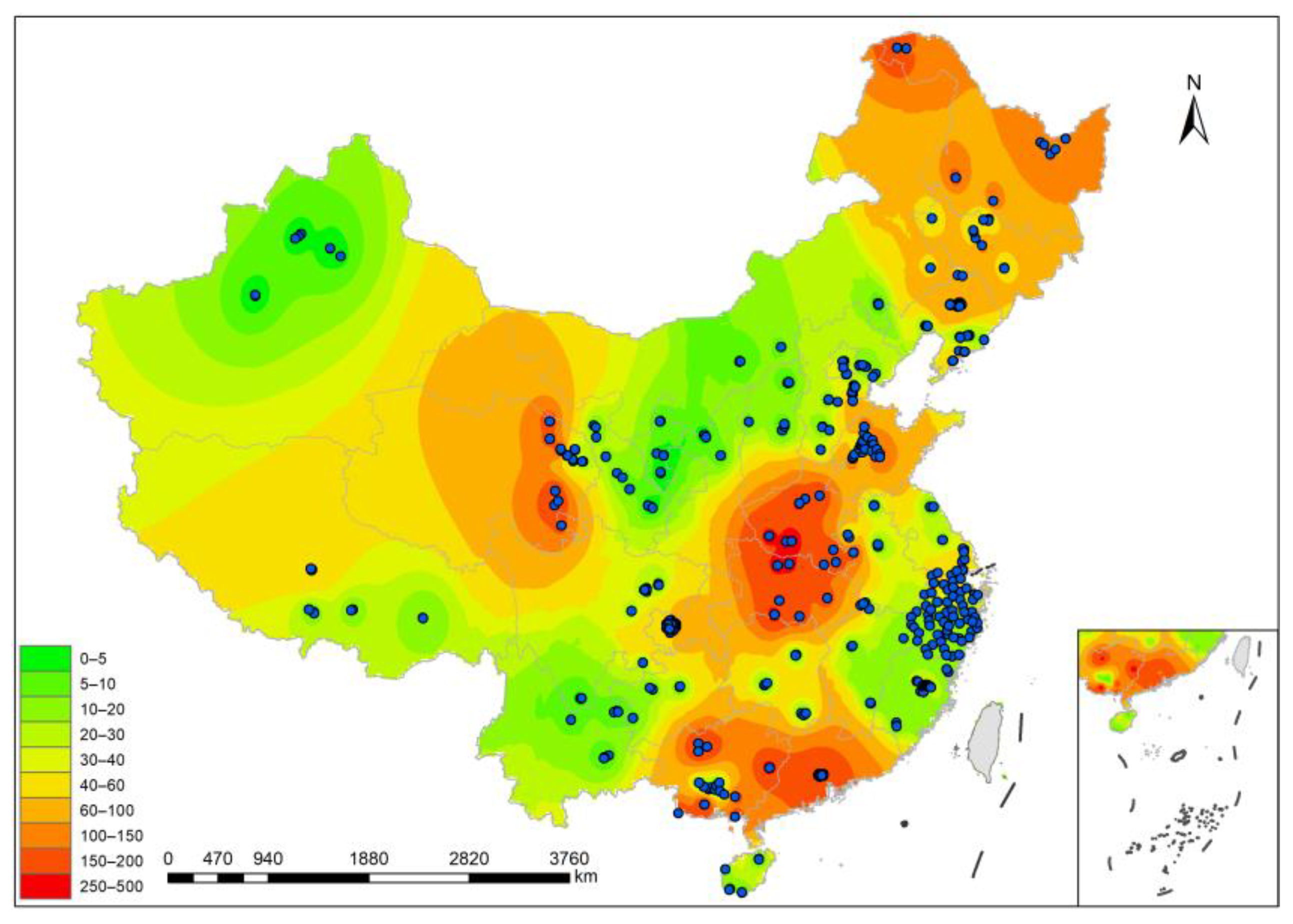
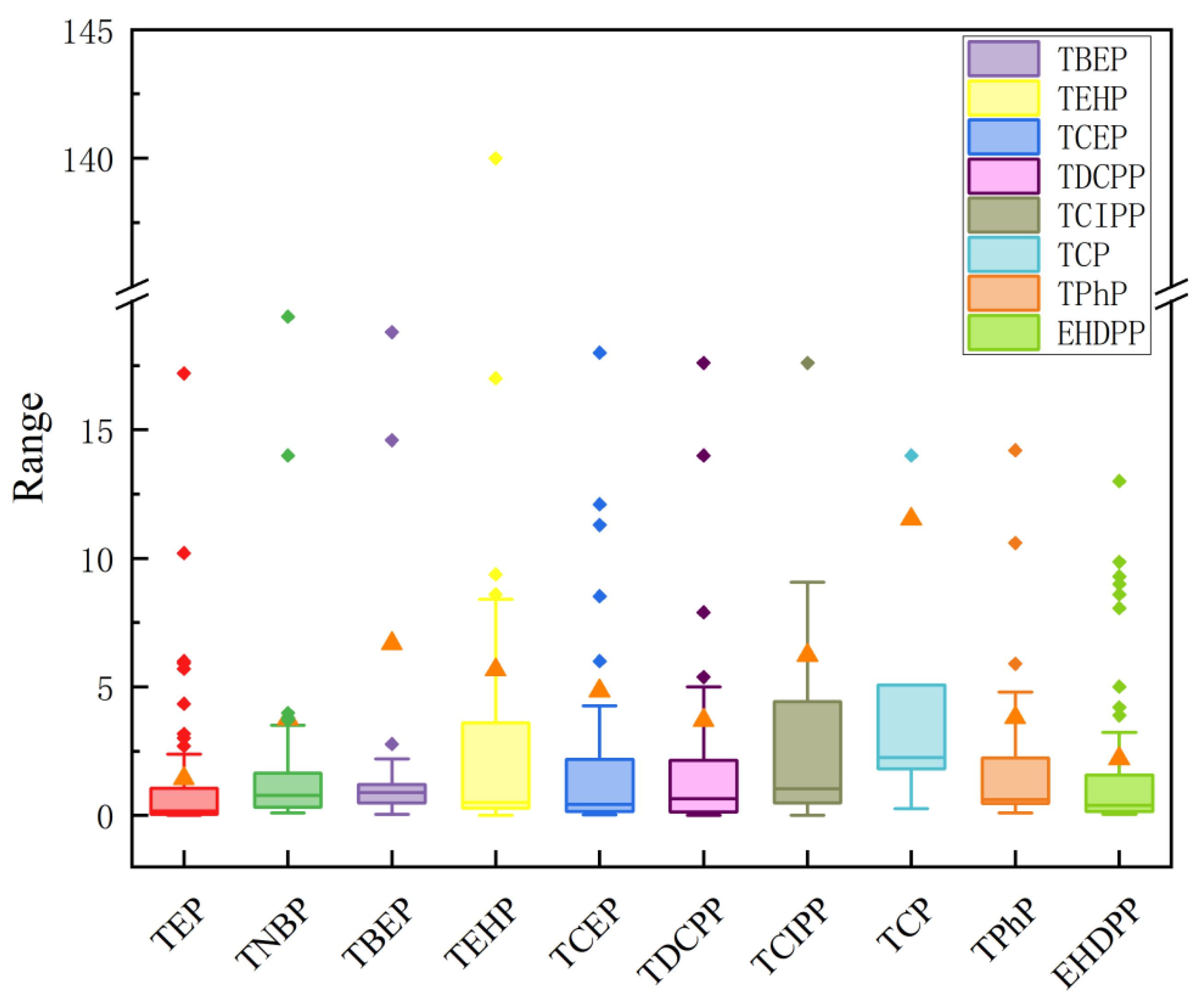
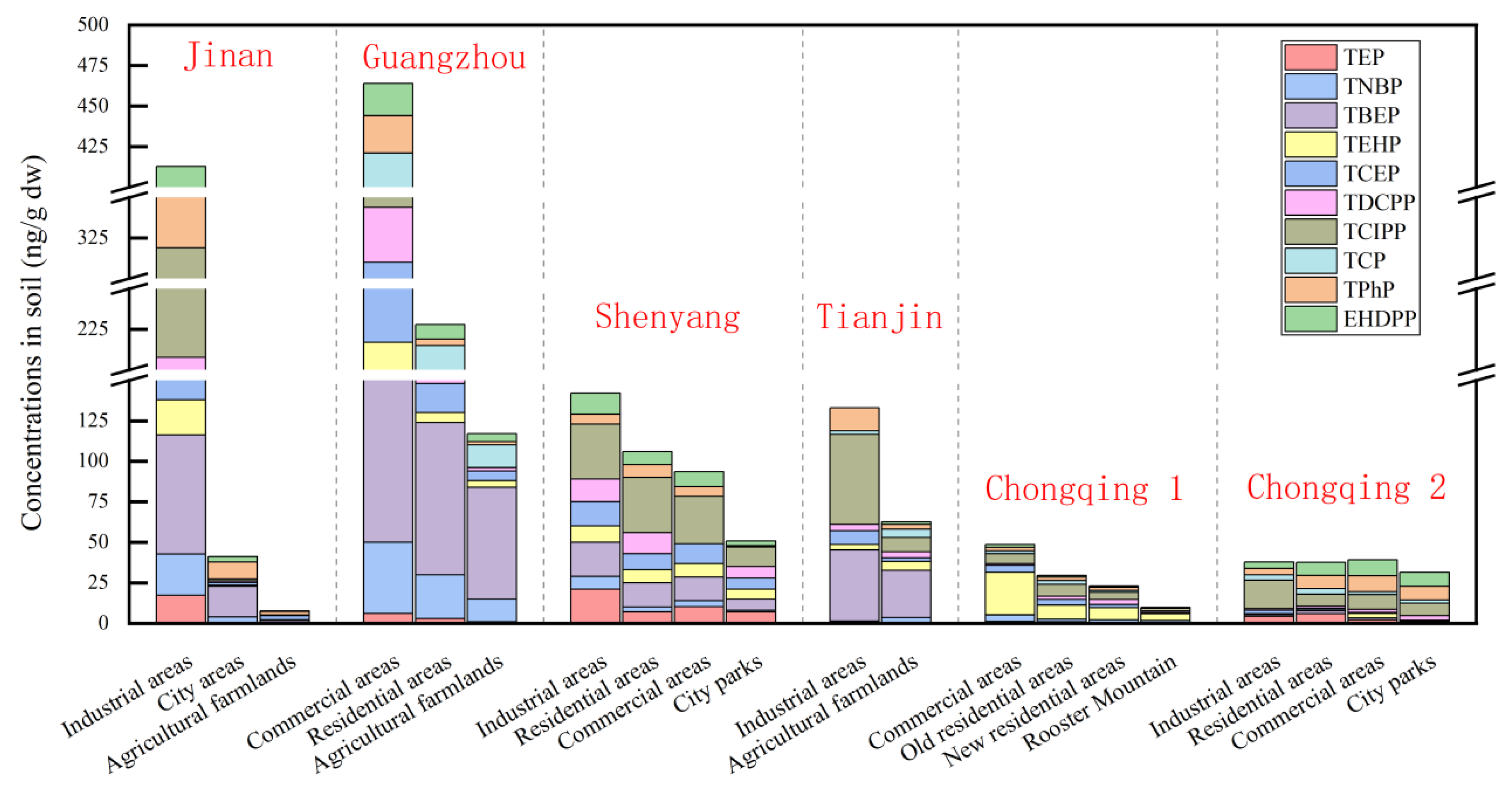
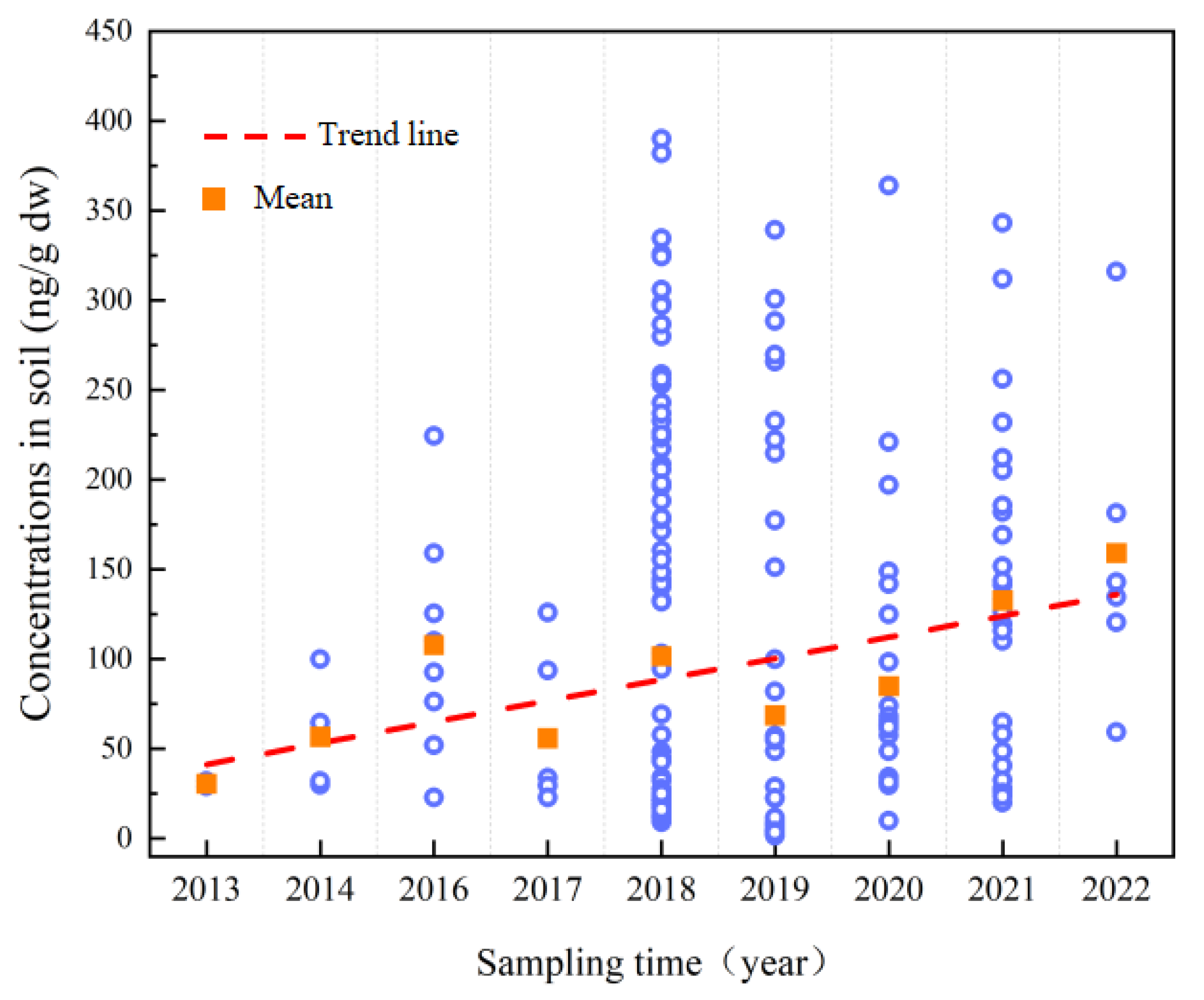
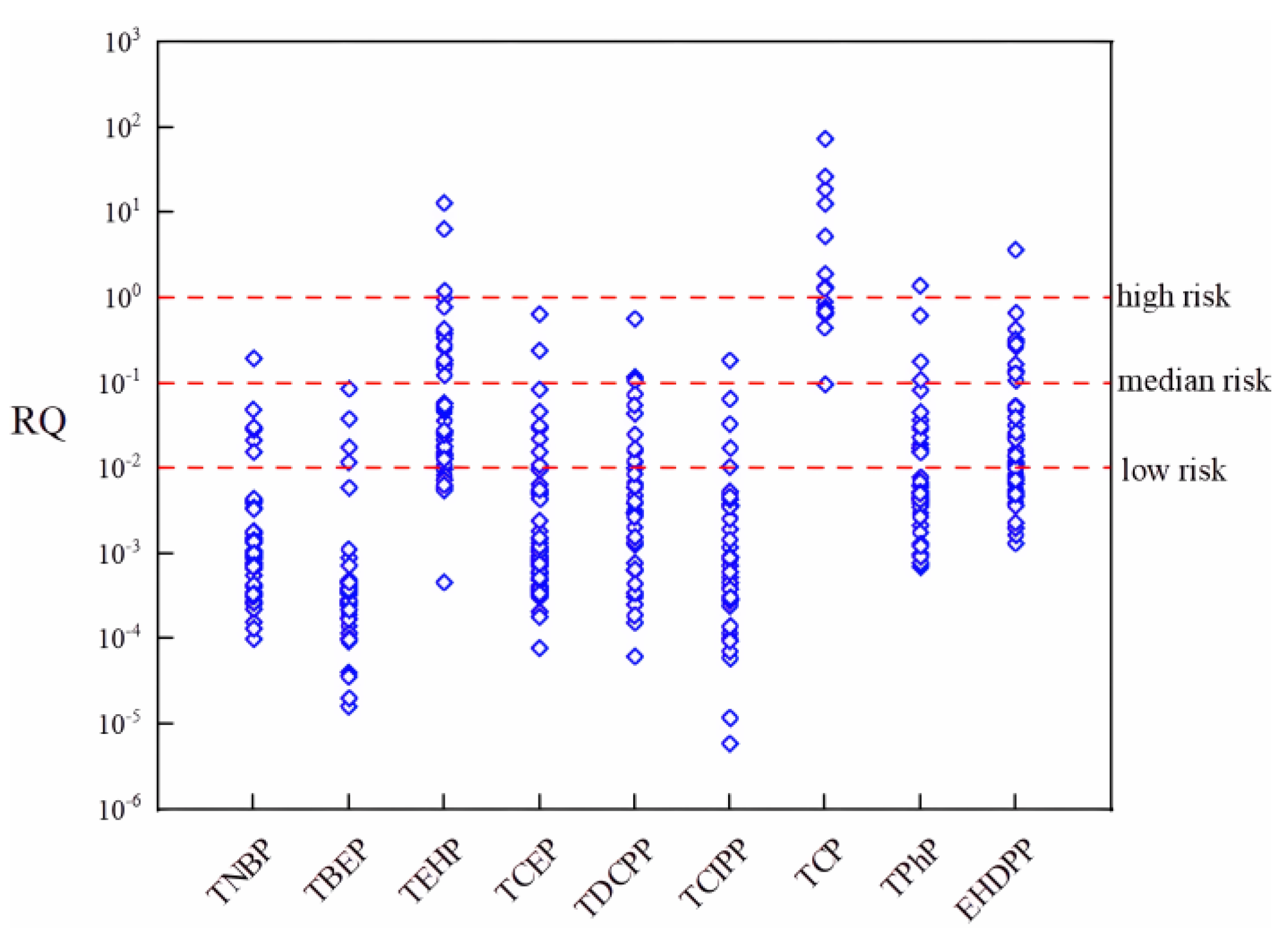
| Regions | ∑OPEs | Median | Mean | Range | Analysis and Results | Reference |
|---|---|---|---|---|---|---|
| Helongjiang, Henan, Hubei, Guangxi | ∑OPE11 | 229 | 230 | 62.3–394 | OPEs are ubiquitous in farmland soils | [44] |
| Dalian | ∑OPE8 | 56.5 | 58.5 | 33.1–136 | The potential risk of TMPP (TCP) is medium to high | [45] |
| The Three Gorges Reservoir | ∑OPE12 | 247 | 266 | 52.1–680 | The concentrations of OPEs in riparian soil exceed those in farmland soil | [46] |
| Jinan | ∑OPE10 | 34.9 | 106 | 2.55–581 | Industrial soils have significantly higher levels of ΣOPE compared with those in urban and farmland soils | [25] |
| Shenyang | ∑OPE13 | 156.2 | 229.8 | 38.7–952.2 | OPE pollution levels are higher than farmland soils and lower than site soils | [47] |
| Ningbo | ∑OPE7 | —— | 469 | 163–986 | TCIPP, TDCIPP, TBOEP and TEHP pose a medium potential risk | [48] |
| Qinghai–Tibet Plateau | ∑OPE7 | 244 | 260.2 | 206.5–333.2 | The main sources of OPEs in plateau soil are atmospheric wet and dry deposition, manufactured consumer materials and the release of OPEs from automobile interior decoration | [49] |
| Shanghai | ∑OPE12 | 86.67 | 90.28 | 35.02–195.56 | The difference in OPE pollution in different regions is great, showing the trend Shanghai > Xiuyan in Liaoning > Yanting in Sichuan > Xining in Qinghai | [50] |
| Shanghai | ∑OPE12 | 78.58 | 78.58 | 40.54–173.29 | ||
| Sichuan | ∑OPE12 | 22.26 | 22.35 | 10.46–35.65 | ||
| Sichuan | ∑OPE12 | 28.55 | 36.82 | 5.46–127.87 | ||
| Qinghai | ∑OPE12 | 16.97 | 17.82 | 4.47–40.2 | ||
| Qinghai | ∑OPE12 | 28 | 30.03 | 9.22–46.9 | ||
| Liaoning | ∑OPE12 | 17.13 | 18.34 | 3.4–32.87 | ||
| Liaoning | ∑OPE12 | 36.22 | 49.62 | 9.77–195.54 | ||
| Chongqing | ∑OPE10 | 61.2 | 77.4 | 10.1–315 | The proportion of TBOEP(TBEP) is higher | [51] |
| Chongqing | ∑OPE12 | 32.5 | 40.4 | 12–80.1 | Exposure concentration is closely related to population density | [52] |
| Chongqing | ∑OPE12 | —— | —— | 10.7–108 | TCPP (TCIPP) and EHDPP are dominant compounds | [53] |
| Tibet | ∑OPE9 | 62.01 | 50.8 | 29.74–73.87 | Pollution mainly derived from building decoration materials, electronic products and polyurethane foam | [54] |
| China (farmland) | ∑OPE11 | 4.9 | —— | 2.41–35.8 | The concentration of OPEs in soils in northeast and South China is significantly higher than that in northwest and central China | [21] |
| Beijing, Hebei, Tianjin | ∑OPE12 | 3.914 | 6.72 | 0.543–54.9 | Cl-OPEs are absolutely dominant, and TCIPP contributed the most | [22] |
| Guangzhou | ∑OPE11 | 240 | 250 | 41–1300 | On the whole, Guangzhou’s urban soil is moderately polluted by OPEs | [43] |
| Tianjin | ∑OPE12 | 171 | —— | 37.1–2700 | Waste recycling is an important source of chlorinated- and aryl-OPFRs in the environment | [24] |
| Beijing | ∑OPE11 | 157 | 299 | 21.4–2050 | The ecological risk of OPEs in Beijing city park soil is at a medium level, and the risk of TCEP, TCIPP and TMPP(TCP) is relatively high | [42] |
Disclaimer/Publisher’s Note: The statements, opinions and data contained in all publications are solely those of the individual author(s) and contributor(s) and not of MDPI and/or the editor(s). MDPI and/or the editor(s) disclaim responsibility for any injury to people or property resulting from any ideas, methods, instructions or products referred to in the content. |
© 2024 by the authors. Licensee MDPI, Basel, Switzerland. This article is an open access article distributed under the terms and conditions of the Creative Commons Attribution (CC BY) license (https://creativecommons.org/licenses/by/4.0/).
Share and Cite
Zhou, G.; Zhang, Y.; Wang, Z.; Li, M.; Li, H.; Shen, C. Distribution Characteristics and Ecological Risk Assessment of Organophosphate Esters in Surface Soils of China. Toxics 2024, 12, 686. https://doi.org/10.3390/toxics12090686
Zhou G, Zhang Y, Wang Z, Li M, Li H, Shen C. Distribution Characteristics and Ecological Risk Assessment of Organophosphate Esters in Surface Soils of China. Toxics. 2024; 12(9):686. https://doi.org/10.3390/toxics12090686
Chicago/Turabian StyleZhou, Guorui, Yizhang Zhang, Ziye Wang, Mingrui Li, Haiming Li, and Chen Shen. 2024. "Distribution Characteristics and Ecological Risk Assessment of Organophosphate Esters in Surface Soils of China" Toxics 12, no. 9: 686. https://doi.org/10.3390/toxics12090686





